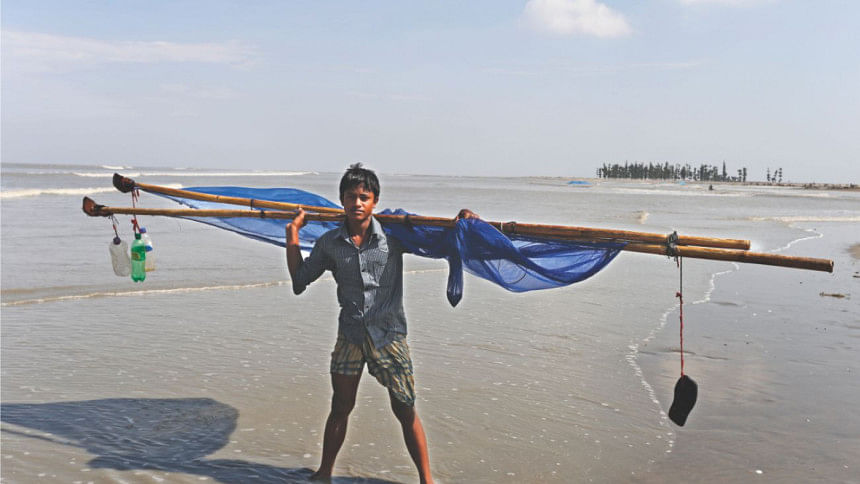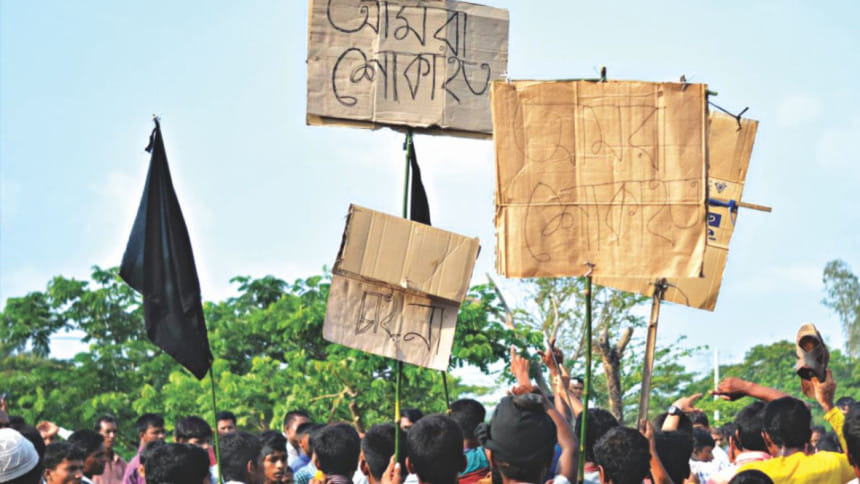How everyday stories of displacement are erased
How many families are displaced due to industrial development in Bangladesh? Ask someone from the Matarbari island of Moheshkhali and he will be able to give an approximation of how many families have been ripped apart in his neighbourhood because of the coal-fired power plant. An activist from one of the numerous villages being cleared away by the industrialisation of Rampal upazila might also be able to answer that.
The state machinery, on the other hand, does not have a system to continuously monitor the internal migration happening as a result of industrialisation. National census surveys are published once every 10 years, allowing for massive changes to happen without documentation. The long arduous process captures macro details, but leaves out the ebbs and flows of people moving in and out. During the year of the last census in 2011, large swathes of Rampal upazila belonged to big shrimp farmers, who would theoretically have been fewer in number in 2001 when the land existed as small agricultural plots. Similarly, the next census report due next year would show communities shuffling around and moving, as shrimp farms have been sold off as industrial plots. The finer granular details—like who moved where, how much compensation was given, whether there was exploitation or use of force—are lost.
Neither does media coverage of industrial displacement take up column space frequently enough to make for holistic documentation. Affected populations generally belong to marginalised areas far away from sadar or town centres, making access difficult for cash-strapped community media. Case in point, this is what an activist from the Malo indigenous group had to say about the way media covered the assault on the Santal communities last year: “Santals were not the only ones whose homes were attacked. There were other smaller indigenous groups too—we had land there as well.” The attack had left around a thousand families displaced.
She proceeds to narrate the incident of a Malo man who was shot in the leg during the attack. “I had to take him to the hospital in the dead of night to make sure the police did not see him leaving and arrest him,” she said. This year, too, popular documentation generalised the entire population by using the identity of the largest indigenous group of that area, to refer to all them. A dearth of regular engagement with communities living further inside the villages means that ethnographic details not generally known by mainstream media, stay unknown. This effectively wipes out the existence and experiences of marginal identities. The media oligarchs own almost all of the long-lasting documentation on this issue and are most cited, beginning from research to court cases.

To top it off, by design, journalists live from story to story, and are ill-equipped to serve as continuous watchdogs in the same way as dedicated ethnographers who commit their time to documenting details. Documentation happens only when and how the documenter chooses to do it. Since these communities are not always powerful, or wealthy enough to stage large demonstrations in the capital city and attract the news cameras, their grievances and acts of resistance remaine unnoticed unless the fourth estate chooses to shed light on them.
Mainstream narratives also fail to document the “before” stages of displacement, for example, smaller displays of power that do not kill, but pressurise communities into moving away. On any legal paper they would be written off as minor annoyances, ignoring the fact that the powerful use these techniques to intimidate communities and grab land.
“Our home is always under water,” said a young woman, a college student from the Matarbari community at an event in the capital last week. “Diseases like diarrhea are widespread in our neighbourhood.” As the area rapidly urbanised, the locals lost control over when the sluice gates of the embankments are to be kept open, causing water-logging in certain neighbourhoods. The flooding of neighbourhoods is just one of the “minor” grievances—how many more are there that have not been documented?
She was speaking at the launch ceremony of a digital library focusing on displacement. The website, called Digital Archive, is a project by Center for Bangladesh Studies and hopes to document anything and everything—filling in the wide blanks left by existing platforms. “Can we become a space for the preservation of memory of those who resisted?” asks Ahmad Ibrahim who is leading the project.
Moheshkhali and Rampal are just two of such examples of course. “We are going through a period where the country is industrialising fast and these cases of displacement are happening more frequently,” adds Ibrahim. There's Chunarughat where the construction of an economic processing zone is about to eradicate tea-garden worker settlements.
“We were brought here as bonded labour during the British era and have lived here for over a century. But we have no rights to the land on which we live and are now being displaced,” said Biren Kalindi, who identifies himself as the son of tea-garden workers. He too was speaking at the launch ceremony.

Antony Rema, a musician of folk band Madol, and a Garo (although he insisted on using Mandi as a more politically correct term) also added to the experience of displacement. “The Madhupur Eco Park disrupted the access that my people had to the forest. We harvested food from the forest but now it is controlled by an authority, who decides what happens on the land and who enters it,” he added.
“Do tourists ever think where the sewage from the hotels in Nilgiri go? They are dumped untreated into the scarce water sources that the indigenous villages are dependent on, forcing them to relocate,” added Uchacha-a-Chak, a researcher from Maleya Foundation.
The stories are endless. The ones reported here came out because members of displaced communities travelled all the way to Dhaka to tell them. It should not be this difficult to be heard.




Comments